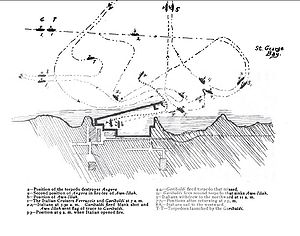Battle of Beirut (1912)
| Battle of Beirut | |||||||
|---|---|---|---|---|---|---|---|
| Part of the Italo-Turkish War | |||||||
 A sketch of warship positions during the Battle of Beirut. |
|||||||
|
|||||||
| Belligerents | |||||||
|
|
|
||||||
| Commanders and leaders | |||||||
|
|
unknown | ||||||
| Strength | |||||||
| 2 armoured cruisers | 1 corvette 1 torpedo boat |
||||||
| Casualties and losses | |||||||
| none | 1 corvette sunk 1 torpedo boat sunk 6 lighters sunk |
||||||
| Civilian Casualties: 66 killed | |||||||
The Battle of Beirut was a naval battle off the coast of Beirut during the Italo-Turkish War. Italian fears that the Ottoman naval forces at Beirut could be used to threaten the approach to the Suez canal led the Italian military to order the destruction of the Ottoman naval presence in the area. On 24 February 1912 two Italian armoured cruisers attacked and sank an Ottoman casemate corvette and six lighters, retired, then returned and sank an Ottoman torpedo boat.
As a result of the battle all Ottoman naval forces in the region were annihilated, thus ensuring the approaches to the Suez Canal were open to the Italians. Besides the naval losses, the city of Beirut itself suffered significant damage from the Italian warships.
During the Italo-Turkish War, the Italian military feared that Ottoman naval forces in the Mediterranean would stage raid on the Italian supply and troopships headed for Italian East Africa. In order to prevent such a raid, Rear Admiral Paolo Thaon di Revel was ordered to clear the harbor of Beirut of what Ottoman naval vessels he might find there. Revel's force consisted of two armoured cruisers: Giuseppe Garibaldi and Francesco Ferruccio. Both cruisers were of the Giuseppe Garibaldi class and armed with two 10 inch guns in turrets, ten 6 inch guns, six 4.7 inch guns, ten 6-pounders, ten 1-pounders, 2 Maxim machine guns, and five torpedo tubes.
In contrast the Ottoman forces consisted of the casemate corvette Avnillah and the torpedo boat Angora. The Angora was a relatively new vessel completed in 1906 and armed with two 37 mm cannons as well as two 14 inch torpedo tubes with a pair of torpedoes per tube. In contrast the Avnillah was an antiquated ironclad corvette built in 1869. After a reconstruction was completed in 1907 she was armed with four 3-inch guns and eight six pounders. In addition to her cannon she was also armed with a single 14 inch torpedo tube. Thus the Ottoman force was entirely outgunned by the Italians, giving them a severe disadvantage in the looming battle.
...
Wikipedia
